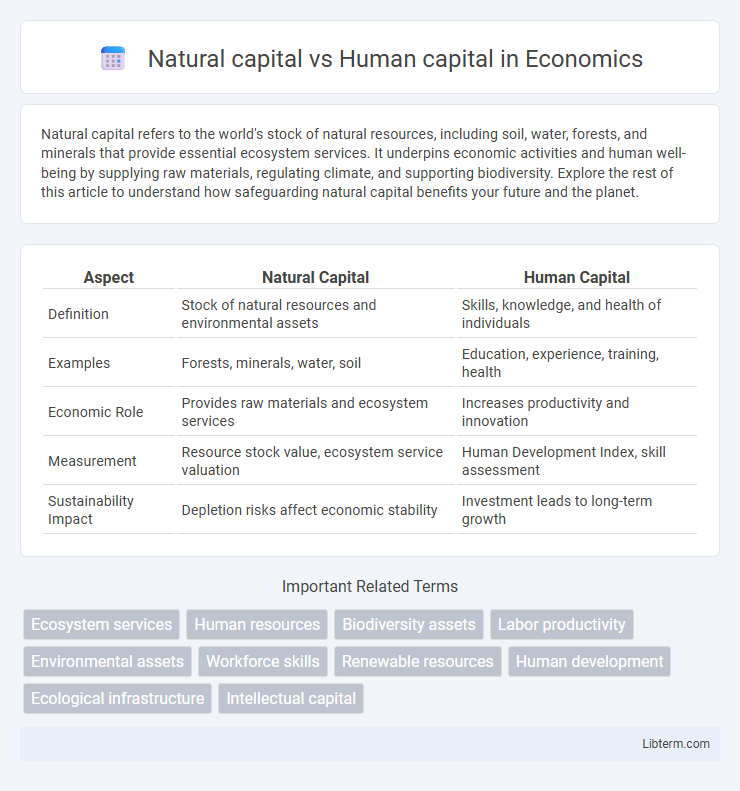Natural capital refers to the world's stock of natural resources, including soil, water, forests, and minerals that provide essential ecosystem services. It underpins economic activities and human well-being by supplying raw materials, regulating climate, and supporting biodiversity. Explore the rest of this article to understand how safeguarding natural capital benefits your future and the planet.
Table of Comparison
| Aspect | Natural Capital | Human Capital |
|---|---|---|
| Definition | Stock of natural resources and environmental assets | Skills, knowledge, and health of individuals |
| Examples | Forests, minerals, water, soil | Education, experience, training, health |
| Economic Role | Provides raw materials and ecosystem services | Increases productivity and innovation |
| Measurement | Resource stock value, ecosystem service valuation | Human Development Index, skill assessment |
| Sustainability Impact | Depletion risks affect economic stability | Investment leads to long-term growth |
Defining Natural Capital
Natural capital refers to the stock of natural resources such as forests, water, minerals, and air that provide ecosystem services essential for human survival and economic activity. It encompasses renewable and non-renewable environmental assets that support biodiversity, climate regulation, and raw materials for production. Understanding natural capital is crucial for sustainable development, as it underpins human well-being and long-term economic growth.
Understanding Human Capital
Human capital represents the economic value of a worker's experience, skills, education, and abilities, driving productivity and innovation within organizations. Unlike natural capital, which includes physical resources like forests and minerals, human capital emphasizes intellectual capabilities and health, influencing labor market outcomes and economic growth. Investing in education, training, and healthcare enhances human capital, directly impacting workforce efficiency and competitive advantage.
Key Differences Between Natural and Human Capital
Natural capital refers to the stock of natural resources like forests, water, and minerals that provide ecosystem services and support economic activities, while human capital encompasses the skills, knowledge, and health possessed by individuals that enhance their productivity. Key differences include the fact that natural capital is physical and renewable or non-renewable in nature, whereas human capital is intangible and develops through education and training. Natural capital often requires conservation to sustain its availability, whereas human capital benefits from investment in healthcare, education, and skill development.
Components of Natural Capital
Natural capital comprises components such as renewable resources like forests, water, and soil, non-renewable resources including minerals and fossil fuels, and ecosystem services like pollination, climate regulation, and water purification. These elements form the foundation for economic production and human well-being by providing raw materials, energy, and environmental functions essential for sustainability. Effective management and conservation of natural capital are crucial for maintaining biodiversity and ensuring long-term resource availability.
Elements of Human Capital
Human capital encompasses skills, knowledge, experience, and health possessed by individuals, driving economic productivity and innovation. Key elements include education, vocational training, cognitive abilities, and social skills, which enhance workforce efficiency and adaptability. Investment in human capital leads to improved job performance, higher income potential, and sustained economic growth.
Importance of Natural Capital for Sustainable Development
Natural capital, encompassing ecosystems, natural resources, and biodiversity, provides essential services like clean air, water, and fertile soil that underpin sustainable development. Its preservation ensures long-term economic growth by maintaining the natural foundations for agriculture, energy, and climate regulation. Prioritizing natural capital enables resilience against environmental risks and supports human well-being through ecosystem services that directly contribute to health and livelihoods.
Role of Human Capital in Economic Growth
Human capital, encompassing education, skills, and experience of the workforce, plays a critical role in driving economic growth by enhancing productivity, innovation, and adaptability in various industries. Unlike natural capital, which relies on finite resources such as land, minerals, and ecosystems, human capital expands through investments in training, healthcare, and knowledge development. Countries with robust human capital tend to exhibit higher GDP growth rates due to improved labor efficiency and the creation of technological advancements.
Interactions Between Natural and Human Capital
Interactions between natural capital and human capital drive sustainable economic growth by enhancing ecosystem services and improving workforce productivity. Investments in natural capital, such as clean air and fertile soil, directly support human capital development through better health and education outcomes. Conversely, skilled human capital fosters effective management and restoration of natural resources, creating a mutually reinforcing relationship essential for long-term resilience.
Challenges in Valuing Natural and Human Capital
Valuing natural capital faces challenges such as quantifying ecosystem services, accounting for biodiversity loss, and integrating long-term environmental impacts into economic models. Human capital valuation struggles with measuring intangible assets like skills, creativity, and social contributions, alongside difficulties in capturing future productivity and education quality. Both require improved methodologies to accurately reflect their contributions to sustainable development and economic growth.
Strategies for Enhancing Both Capitals
Investing in sustainable resource management ensures the preservation and regeneration of natural capital, while promoting education, skills training, and healthcare advances human capital development. Integrating environmental policies with technological innovation fosters ecosystem resilience and improves workforce productivity. Collaborative efforts between governments, businesses, and communities drive comprehensive strategies that enhance both natural and human capital for long-term economic growth.
Natural capital Infographic

 libterm.com
libterm.com